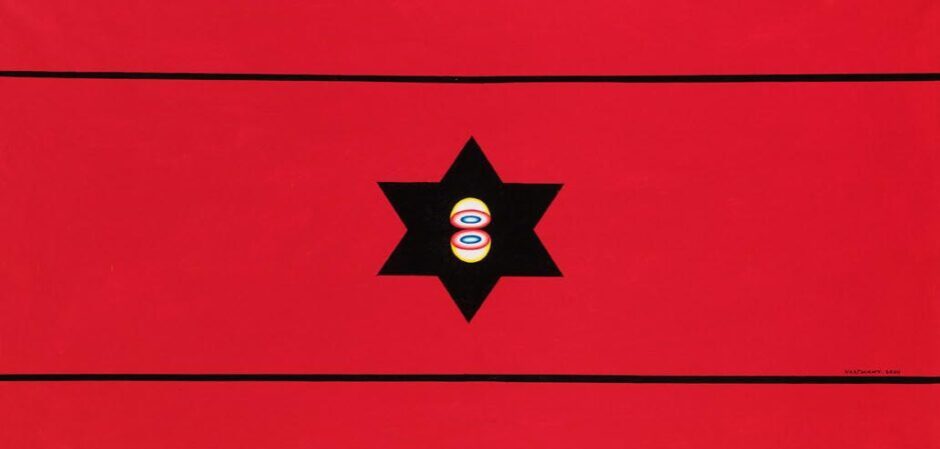A ROSE IS A ROSE
„…LOVE IS AS STRONG AS DEATH“
(Song of Songs 8:6-78:6)
Roses have always been associated with women and beauty, but also, profoundly, to life and death, to the intense relationship that links them to the plexus of EROS and THANATOS.
It is said that the first white rose appeared when Venus emerged from the water, while the first red rose arose when the white rose became stained with the goddess´s blood when she was pricked by its thorns during her futile attempt to rescue her beloved Adonis from the jaws of death.
But the nature that is thus transformed, is also human. CARMEN REATEGUI perceives and proposes this in succesive pictorial depictions of the lifecycle of the rose. In 2009, she exhibited thirteen roses rather than twelve of them, all white, at different moments of the lifecycle, suggestive of a lunar calendar and a menstrual cycle. In this exhibit, the twelve flowers are intensely red, nearly black.
Vitality becomes agonizing passion, revealing the dark side of our opposing drives. A thanatological EROS where pain is another way to ecstasy, as in the art of painting: exhausting and grueling, but enjoyable. There is an obsessive insinuation in the hedonic discipline when these petals are painted on canvas like makeup on the body. A twist of opposite sensations that disturb us from the folds and transparencies of artistic intervention.
Suggestive, perturbing forms, extant in the preceding white sequence, become blurred by the renewed pictorial vigor where red now prevails. These ripe, instinctive and dark roses also depict the Black Prince roses the painter grows in her own garden. REATEGUI´s rose garden at the Hacienda Santa Rosa becomes a mutable but eternal setting, identifying in the vortex of flowers and thorns a delicate single white bed: her bed as a teenager, where her earliest desires were suffered and awakened.
A flag, Peruvian and personal, emblematic of mystical and carnal purity.
SUSANA TORRES
TEXT: CATALOGUE – ROSE PROJECT – galerie wuensch aircube – 2012
ALL THANATOS FOTOS: CARMEN REATEGUI ROSSELLO
EVEN DEATH IS FORTHCOMING
Gustavo Buntinx
Violence and religion: two great currents in the iconic abundance of Peruvian art in the last two decades. and between the two, at times hidden, at times eruptive, a profound sexuality: Erotic and Thanatic:
There is no contradiction in this but a paradoxical revelation. And a constant exchange of fluids, bloody as much as seminal. Two decades of civil war and a dictatorship have made us Peruvians finally, painfully, contemporary in and of ourselves, as prefigured by Mirko Lauer in 1991. A new mestizaje returns our existence to primordial emotions. From certain perspectives, it is also a personal and cosmic drama that is insinuated after a historic (melo)drama: the agony of the living body on earth, our own corporal fragility.
However, agony is not death, but a fight on the way to death with death. This is how Carmen Reategui has visualized it. Through her judicious artistic process one visualizes a complex political reflection, always in existential terms, (and) almost always spiritual. Contemplate the perpetual present state of gigantic tree assassinated in 2001, which inverted like a chalice,elevates the cry of its hurt dignity to the heavens. And now the esoteric silence of the great urn arranged for scarcely some petals. White. Precise synecdoche of the crystal hearse that projects and exalts the impressive marmorean interpretation of the transit of Santa Rosa in front of her tomb in the temple of Santo Domingo.
This magnificent work was realized in 1669 by Melchiore Caffa, whom one is used to associating with the baroque reverberations of Gian Lorenzo Bernini. And there is a certain link – also a difference – between the preorgasmic ecstasy of Santa Teresa de Jesus, at the point of being divinely run through by an angelic lance, and the posthumous languishing of our patron saint, accompanied by the last caresses of the seraphim.
In the intensity of this other passage is located the discourse of Carmen`s paintings as an evolving installation that confronts us with erogenous interiors of precisely thirteen, (not twelve) moments in the life cycle of the rose. From the luxuriant bud to the withered petal, the corolla exhibits itself impudently, „withering in its beauty, but more human, less flower,“ in the artist`s words. Progressive images of the fecundity and menopause that paradoxically reaffirm life: the same passion, apparent even in the last exhalations of life.
Perhaps that may be the crucial distinction between Reategui and the exuberantly celebratory genital floriations of Georgia O`Keefe. There is hidden in Reategui an element of vanitas and of memento mori which is intuitive of the link between mysticism and the sensual experience. That impulse towards relegion is derived also from sexual propulsion.
From there the biblical association looked for is to be found in the abruptly erotic Song of Songs. And the organic association with the vulva as the personified vortex of all nature. Per Courbet and Lacan, this is The Origin of the World. And time: the numeric order of this exposition alludes not to the stable and phallic solar calendar (intihuatana) but to the muvable lunar and feminine calendar (paqarina) with its 13 lunar moons per calendar year – an astral deviation associated with the most vast and intimate fluids: Oceanic and menstrual.
Tides of the earth and the body. A permanent mutuation that nevertheless counterbalances and endures in its extreme and sacred maniestations:it is the lunar cycle that even today determines Christ`s Passion – Easter.
In its fall, the flower scatters the seeds. And „love is strong like death“ (Cant.8:6).
Even death is forthcoming.
(Translation by Dianne Reategui and Lynn Ehlers)
fotos| galerie wuensch aircube
WORDS SHOWN ARE BASED ON THE FIRST FOTOEDITION-MAP (35x35cm,1/1) MADE BY THE ARTIST.


























Du muss angemeldet sein, um einen Kommentar zu veröffentlichen.